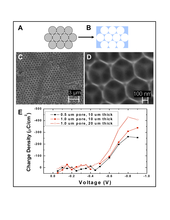Highlight
Effect of Network Geometry on Electron Movment in a Titania Photoanode
Achievement/Results
Background: Choosing the best colloidal assembly method (dip coating, sedimentation, or electrophoresis) the self-assembly of colloidal particles of various sizes into ordered, opal structures is facilitated (Figure A). Infiltration of the opal structures with a titania pre-cursor and sintering at 450ºC yields inverse opal structures where the position of void and solid areas is inverted (Figure B).
Results: 10 um thick films of titania inverse opal structures on conductive glass substrates have been produced. Electrodes with pore sizes ranging from 0.5 – 5 um have been produced (Figure C & D). Inverse opals titania electrodes display electrode-like behavior. The effect of pore size and film thickness on charge density is revealed (Figure E).
Address Goals
Impact: Goal 1: The utilization of an ordered electrode structure leads to an improved overall efficiency of the dye-sensitized solar cell. In addition, the pore size control allows flexibility in the dye choice. The study provides a way to understand the effect on network geometry on electron movement in the electrodes. As a result, the efficiency of dye-sensitized solar cells might be increased from the currently reported ~10 % leading to a better applicability of dye-synthesized solar cells in alternative energy capture securing the Nations position in this area.
Goal 2: The student carrying out this study is female. As such, her research activity presence a role model to other female students both at the undergraduate and masters’ level. As such the activities help to generate a world-class, broadly inclusive science and engineering workforce and expand the scientific literacy of all citizens.






